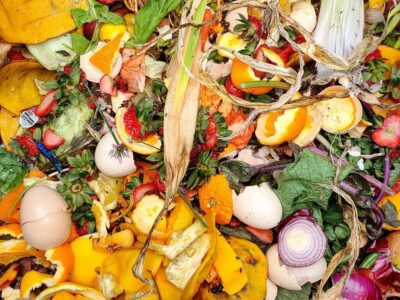Before the pandemic, our Morningside Heights apartment building had brown, plastic-sealed garbage cans in the basement that held our food waste. They were collected by the New York City Department of Sanitation and brought to an aerobic digester that converted the food waste to fertilizer and methane. Mayor DeBlasio, in his pandemic panic, ended the practice, which has still not been resumed. The city’s curbside composting pick-up has resumed in Queens and four community board districts in Brooklyn, one in the Bronx, and two in Manhattan. About one-third of New York City’s 24 million pounds of daily garbage is food and other organic waste. This provides enormous potential for diverting waste from landfills.
Food waste is an environmental disaster that can be easily transformed into an environmental solution. According to Eric Goldstein of the NRDC:
“The overwhelming majority of the city’s discarded food scraps and yard waste is sent to landfills or incinerators. But when buried at landfills, these organic materials break down and release methane, a very potent global warming gas… There’s another problem associated with the current system of combining food waste with other trash that New Yorkers place out at curbside for Sanitation Department collection: the black bags containing these putrescible mixed wastes provide easy food access for the city’s increasingly brazen rat population. In contrast, composting organic waste offers numerous advantages. It is a natural process that advances the decomposition of food scraps, yard waste and food-soiled paper and results in finished compost, which is rich in nutrients and resembles fertile garden soil. Finished compost is used as a soil supplement that reduces the need for chemical fertilizers, prevents erosion, helps retain moisture and aids in the growth of crops, street trees and houseplants… Another option, which is also preferable to landfilling or incineration, is to send the collected food scraps and yard waste to anaerobic digesters. Like composting, anaerobic digestion is a natural process that uses bacteria to break down organic matter. But unlike composting, anaerobic digestion takes place in a sealed tank; the breakdown of organics in this setting produces “biogas,” primarily methane, which can be captured and used to replace fossil-fuel generated natural gas.”
For a city with as much food waste as New York, composting may require too much land to be practical, and in our situation, we will need to build a few large-scale anaerobic digesters. In addition to biogas, a digester produces digestate, which according to the EPA, is:
“…the residual material left after the digestion process. It is composed of liquid and solid portions… With appropriate treatment, both the solid and liquid portions of digestate can be used in many beneficial applications, such as animal bedding (solids), nutrient-rich fertilizer (liquids and solids), a foundation material for bio-based products (e.g., bioplastics), organic-rich compost (solids), and/or simply as soil amendment (solids), the latter of which may include the farm spreading the digestate on the field as fertilizer.”
The gas and fertilizer produced by the digester have economic value that can help pay the costs of waste treatment. Still, advances in waste management always seem to lose out in the city’s budget competition. I’m reasonably sure the rat population favors sloppy food management, but I can’t figure out why our city government can’t make food waste recycling a higher priority. Mayor Adams was unimpressed with the food waste plans he saw when he arrived at City Hall—which is fair enough—but the pace of implementation since he came to office seems glacial. I wonder if much of an effort has gone into finding a private sector partner to monetize the fertilizer and biogas production from anaerobic digestion. A system could be set up to produce new facilities that would reduce the cost of waste transport and landfill tipping fees and recover some revenues from the products of food waste. The sheer volume of the city’s food waste might make this economically feasible. And none of this includes commercial food waste from restaurants and other for-profit businesses that serve food. A combined sanitation department and private carter program is worth exploring.
The effort in Queens was advertised as a first step in a city-wide effort. According to Anne Barnard of the New York Times: “City organics waste goes to a facility on Newtown Creek, which turns it into renewable energy, and to a city composting site on Staten Island, which turns it into soil that is given to parks and community gardens or sold in bulk.” When food waste recycling covers more parts of the city and elicits a higher participation rate, its cost efficiency will grow, as will the need for a larger-scale use of the products of food waste.
Food waste provides an opportunity for New York City to place itself on the cutting edge of waste recycling. Unlike other forms of waste separation at its source, food is easy to distinguish from the rest of one’s household garbage. The sealed containers double as a rat control measure, an aspect of food waste recycling building staff are attracted to. The capital costs for new facilities can be funded by the reduction of landfill tipping fees and, possibly, by the revenues generated from fertilizer and biogas.
The act of waste separation can help educate people about the volume of waste we produce and the need to find a productive use for that waste. The idea that waste can be transformed into a useful product is the core concept of the circular economy, where a linear production model of “produce, use, and waste” is replaced by a circular model where everything is used and nothing is wasted. My own view is that a true circular economy must be built on systems of automated reuse rather than voluntary, manual material separation. In July 2021, I wrote that:
“In the long run, [waste circularity] … will be accomplished by automated waste sorting machines that can take mixed garbage and sort it for re-use. Recycling at the household level is a good educational tool that can increase public awareness of the waste that we all produce, but it is an inefficient and flawed method for separating materials for re-use. Often the recycled waste is contaminated, and the uncertain demand for recycled material has frequently led to recycled waste ending up in landfills or incinerators. If we are to ever achieve a circular economy and something approaching zero waste, we cannot rely on current collection methods and technologies. Fortunately, advanced robotics and artificial intelligence are helping to bring about rapid advances in waste sorting technology. The capital costs of these technologies and the absence of a track record for use in the real world are obstacles to implementation, but a number of cities already use automated waste sorting technologies, and more will follow.”
I recognize that our streets lined with black plastic bags of rat-enticing waste seem quite removed from a world of sealed waste containers and automated waste sorting and mining facilities. Nevertheless, the growing capital and daily expense cost of waste collection and disposal provides a revenue stream available to modernize and reimagine the waste management system. A city that once was audacious enough to buy large expanses of land north of the city to create a water system that still provides a wonderful supply of clean water should be capable of developing a waste disposal and mining system that could be the foundation of a circular economy.
This long-term solution will be decades in the making. In the near term, I’d settle for a system of city-wide food waste disposal and recycling built on sealed plastic bins and current technology such as anaerobic digestion and composting. We need to start somewhere, so let’s start with expanding what we already have managed to do.
Views and opinions expressed here are those of the authors, and do not necessarily reflect the official position of the Columbia Climate School, Earth Institute or Columbia University.




Thinking about doing my senior thesis on this subject – would love to hear your current thoughts on the matter !